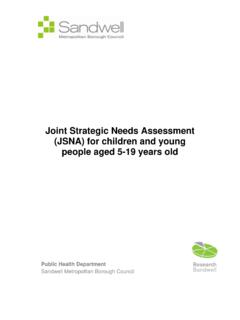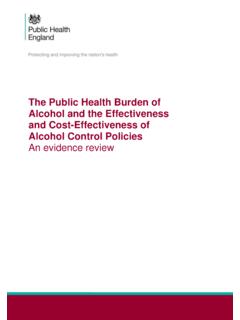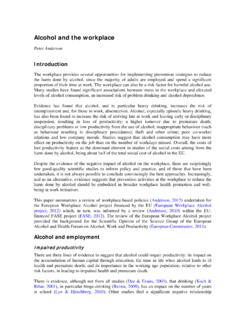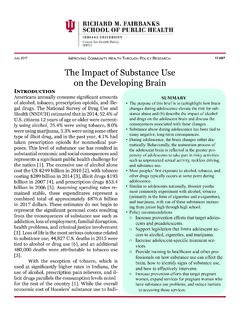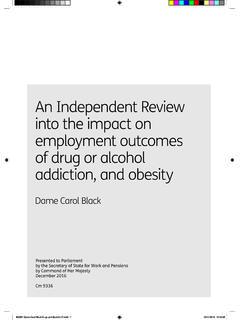Transcription of A STUDY ON THE ALCOHOL CONSUMPTION PATTERNS …
1 A STUDY ON THE ALCOHOL CONSUMPTION PATTERNS AND THEIR PREFERENCE OF LIQUOR OVER WINE AMONGST THE YOUTH IN MANIPAL Naresh Nayak P.* *Assistant Professor, Accommodation Operations, Welcomgroup Graduate School of Hotel Administration, Manipal University, Manipal. Email: Narayan B. Prabhu M.** **Assistant Professor, Marketing & Strategic Management, Welcomgroup Graduate School of Hotel Administration, Manipal University, Manipal. Email: Abstract CONSUMPTION of alcoholic beverages in different parts of the world is influenced by economic, social, religious, and traditional forces; therefore countries differ significantly in the amount and type of ALCOHOL consumed and in the temporal trends of use of alcoholic beverages.
2 India has the world s largest youth population which is getting influenced by external factors and has started consuming ALCOHOL at a much higher rate and from a smaller age. Drinking ALCOHOL is a major activity among college students. Excessive research on this subject has focused on students motivations for binge drinking little research has investigated the leisure context in which student s ALCOHOL drinking PATTERNS , and their preference of ALCOHOL over wine. Wine CONSUMPTION has witnessed tremendous growth in India over the past 10 years. The Indian players enjoy a large market share of nearly 90% (Sommelier India, 2010) although International brands such as Moet & Hennessey, E&J Gallo are now picking up.
3 There are over 25000 students in Manipal which is a large number for such a small city and therefore is a target market for many industries. STUDY was to identify ALCOHOL CONSUMPTION PATTERNS among young people and their preference of liquor over wine of the age group between 18-25 years. A survey research was conducted using questionnaire as a primary tool for data collection which consisted of 19 closed ended questions. The STUDY also tries to identify the importance of certain attributes that may affect youngster s ALCOHOL CONSUMPTION frequency, ALCOHOL purchasing habit and ALCOHOL selection process. Keywords: ALCOHOL CONSUMPTION , wine, youth, Manipal Introduction India is the third largest market for alcoholic beverages in the world.
4 The demand for spirits and beer is estimated to be around 373 million cases. (Source: Annual Report, Government of India, Ministry of Food Processing Industries). In India, majority of distilleries manufacture ALCOHOL from Sugar Cane Molasses compared to international trend of grain based (rice, wheat, millet, Barley, corn and oat) ALCOHOL . In India, since ALCOHOL is largely produced from sugarcane molasses, the industry is cyclical in nature, as sugarcane production itself is affected every 3-4 years due to monsoon and other factors, resulting in low availability of molasses. ALCOHOL industry is the second largest source of revenue of the State Exchequer , 000 cores.
5 The Industry turnover is ~ ,000 core (Source: Euro monitor International 2009). It is the only Industry where inputs are decontrolled (free market price) and output is controlled (selling price is determined by State Excise in most States). India has traditionally been among the world s lowest per capita consumers of foreign spirits such as whisky, rum, brandy, vodka and gin. Indian Made Foreign Liquor (IMFL) is an industry term of art in India used to describe these foreign spirits that are now made in India, which are distinguished from traditional country liquor, historically manufactured in India. In addition, IMFL is distinguished from beer and wine. Indian Spirits Sector - Overview Indian Liquor Industry with estimated market value of INR 340 billion is growing at 12-15% over the last two years.
6 The sector is expected to maintain its CAGR of ~15% while the premium segment Wine and Vodka is expected to grow at a higher rate. With consolidation and foreign acquisitions gaining steam the sector is about to witness next phase with realization rising in line with that of their foreign counter parts. There are 325 distilleries in India, with an installed capacity of about billion litres of liquor. However, production rate is about 40% of total licensed capacity as total requirement of liquor stands at billion litres. Major National Player s united spirits with about 60 % of market share in IMFL is the undisputed leader. Wine CONSUMPTION in India Wine is simply defined as an alcoholic beverage obtained by the alcoholic fermentation of fresh or dried grapes, or other fruits such as gooseberries.
7 This term is also sometimes applied to the juice of grapes, fresh grapes or other fruits. Wine is also usually categorized by the type of grape used and maybe red, white or rose. When carbon dioxide is added with pressure to it, it becomes sparkling wine. Commercial wine grape production, however in India was begun only in 1980 s. Over the last 2 decades, the wine industry has seen a tremendous growth with a continuous CAGR of 25% over the past 3 years (Sommelier India, 2010). Wine CONSUMPTION has witnessed tremendous growth in India over the past 10 years. The Indian players enjoy a large market share of nearly 90% (Sommelier India, 2010) although International brands such as Moet & Hennessey, E&J Gallo are now picking up.
8 With the recent initiatives taken up by the government to exempt excise duty, the industry is booming. Wine is now treated as a low ALCOHOL beverage and is consumed by the young and old alike. At present the wine CONSUMPTION trend in India is mostly controlled and directed by the upper class constituting only about 2% of the population which comes up to 20-25 million. Many of these individuals have an increased disposable income, international experience and lifestyles. They are more exposed to wine industry and the latest trends. It is estimated that the highest CONSUMPTION of wine takes place in metro cities Mumbai, Bangalore and Delhi - 80%. Also 69% of wine CONSUMPTION takes place in restaurants and pubs (Sommelier India, 2010).
9 There are a lot of barriers for the growth of wine industry in India, like majority ALCOHOL consumers in India prefer hard liquor (whiskey, rum etc), spirits (vodka, gin etc) and beer. India has the world s largest market for whiskey which accounts for 80% of the entire market, whereas beer occupies only 4%, spirits are 14% and wine consumers are only 2 %. Purpose of the STUDY 1. To understand ALCOHOL CONSUMPTION pattern in Manipal. 2. Factors Influencing students to choose other liquors over wine. 3. To know there opinion on wine and its market. 39%23%9%9%20%Major wine consuming Indian citiesMumbaiDelhiBengaluruGoaRest of India80%14%4%2% ALCOHOL Preferencewhiskyspiritsbeerwine Literature Review ALCOHOL arguably is both the oldest social beverage and the substance most widely used by human beings.
10 Its power to change behaviors positively and negatively is extraordinary, although both the reasons and effects for drinking vary widely from culture to culture (Pettigrew and Charters, 2006 Measham, 2008 ; Ormrod, 2009). It is widely accepted that ALCOHOL is used to enhance positive emotions and to cope with negative emotions and that positive impacts are likely to result in positive life experience; while on the other hand, ALCOHOL CONSUMPTION can also lead to negative impacts, such as immorality and crime (Bellis et al, 2005 ). Recently, there is also a mixed message of the pros (for example normality and sociability of drinking) and cons (for example health warnings) of ALCOHOL CONSUMPTION (see Measham, 2006 ).
